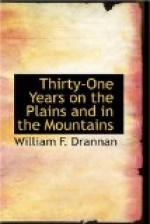This was the last I ever saw of the girl, but have heard various reports concerning her since. I have been told that Mrs. Jackson raised money at the Fort to send her to San Francisco to have the tattoo marks removed from her face by the celebrated Dr. Fuller of that city, but they having been formed with vegetable matter, he was unable to remove them. I was also informed that she was afterwards sent to New York for the same purpose, but with no better success.
Only a short time ago, since coming to Idaho, I heard that she had really found some of her relatives somewhere in the state of Oregon, where she remained and raised a family; while a still later report is that she is married to a rich merchant and is living somewhere in the state of New York.
I have often thought of this poor girl since, and it has always been a question in my mind whether I did right in taking her away from the Indians after she had been with them so long; but if I did do right, and she or any of her relatives should by chance see this work and glance over its pages, I wish to say that to that kind-hearted Indian girl of the Pima tribe, Nawasa by name, and her brother belong the praise of rescuing Olive Oatman from the Apache Indians.
In the first place, had it not been for her and her brother, I would never have known of the girl, and even after I knew she was there, I could not have done anything without Nawasa’s assistance, for she could not have worked more faithfully and earnestly if there had been a thousand dollars in the operation for her.
On my return trip I rode the first day to the Pima village and remained there that night.
I hired my young Indian friend to go among the Apaches and trade beads for furs, and he went home with me.
Nawasa was very anxious to know how I got through with the girl, but did not dare say anything while in camp; so the next morning when her brother and I were leaving she caught a horse and rode with us some distance. As soon as we were out of hearing of the other Indians, she and her brother commenced asking all sorts of questions concerning the girl; whether I thought she would be happy with her own people or not.
Those Indians had learned in some way that somewhere, a long distance away, the white people had great villages, and Nawasa asked if I thought the white girl would be taken to the large cities.
The young Indian and I arrived at our camp about four o’clock that afternoon and found Jim Beckwith in a splendid humor, for he was glad to see me. He had given up all hope of ever seeing me again, for he thought the Apaches had followed me up and killed me. I told him what I had brought the young Indian for, and he was well pleased with the arrangement.
We fitted him out with beads that cost us twenty dollars, and tin pans and blankets, agreeing to come to his village in two weeks for our furs.
When the two weeks were up we took our pack-horses and went to the village, and to our surprise he had traded off the beads and blankets to much better advantage than we could have done ourselves.




